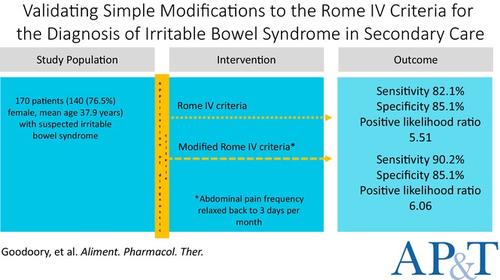当前位置:
X-MOL 学术
›
Aliment. Pharm. Ther.
›
论文详情
Our official English website, www.x-mol.net, welcomes your
feedback! (Note: you will need to create a separate account there.)
Validating Simple Modifications to the Rome IV Criteria for the Diagnosis of Irritable Bowel Syndrome in Secondary Care
Alimentary Pharmacology & Therapeutics ( IF 6.6 ) Pub Date : 2024-10-28 , DOI: 10.1111/apt.18363 Vivek C. Goodoory, Christy Riggott, Mais Khasawneh, Christopher J. Black, Alexander C. Ford
Alimentary Pharmacology & Therapeutics ( IF 6.6 ) Pub Date : 2024-10-28 , DOI: 10.1111/apt.18363 Vivek C. Goodoory, Christy Riggott, Mais Khasawneh, Christopher J. Black, Alexander C. Ford

|
BackgroundThe Rome IV criteria for irritable bowel syndrome (IBS) may be too restrictive for clinical practice and research.AimsTo validate the Rome IV criteria and study the diagnostic performance of simple modifications to them.MethodsWe collected symptom data from consecutive adults with suspected IBS seen in a single clinic. We used a reference standard to confirm IBS (presence of lower abdominal pain associated with altered stool form or frequency; no evidence of organic gastrointestinal disease after limited investigation). We applied Rome IV criteria, but also two modifications. First, we re‐incorporated abdominal discomfort but kept symptom frequency required for both abdominal pain and discomfort to at least 1 day per week. Second, we included only abdominal pain but relaxed symptom frequency back to 3 days per month. We calculated sensitivity, specificity and positive and negative likelihood ratios (LRs), with 95% confidence intervals (CIs), for each diagnostic criterion.ResultsWe recruited 170 patients (76.5% female, mean age 37.9 years). Sensitivity and specificity of the Rome IV criteria were 82.1% and 85.1%, respectively; positive and negative LRs were 5.51 (95% CI 2.95–11.3) and 0.21 (95% CI 0.14–0.31), respectively. Modifying the criteria by relaxing the frequency of abdominal pain to 3 days per month led to the best performance [sensitivity 90.2%, specificity 85.1%, positive LR 6.06 (95% CI 3.25–12.2), and negative LR 0.11 (95% CI 0.07–0.19)].ConclusionsThe Rome IV criteria performed well in diagnosing IBS. A simple modification relaxing the required frequency of abdominal pain improved their performance.
中文翻译:

验证对二级保健中肠易激综合征诊断的罗马 IV 标准的简单修改
背景肠易激综合征 (IBS) 的罗马 IV 标准对于临床实践和研究来说可能过于严格。目的验证 Rome IV 标准并研究对其简单修改的诊断性能。方法我们收集了在单个诊所就诊的连续疑似 IBS 成人的症状数据。我们使用参考标准来确认 IBS(存在与大便形状或频率改变相关的下腹痛;经过有限的调查,没有器质性胃肠道疾病的证据)。我们应用了 Rome IV 标准,但也应用了两项修改。首先,我们重新纳入了腹部不适,但将腹痛和不适所需的症状频率保持在每周至少 1 天。其次,我们只包括腹痛,但将症状频率放宽至每月 3 天。我们计算了每个诊断标准的敏感性、特异性、阳性和阴性似然比(positive and negative likelihood ratios, LRs),以及95%置信区间(confidence intervals, CIs)。结果我们招募了 170 例患者 (76.5% 为女性,平均年龄 37.9 岁)。Rome IV 标准的敏感性和特异性分别为 82.1% 和 85.1%;阳性和阴性 LRs 分别为 5.51 (95% CI 2.95-11.3) 和 0.21 (95% CI 0.14-0.31)。通过将腹痛频率放宽至每月 3 天来修改标准,可获得最佳效果 [敏感性 90.2%,特异性 85.1%,阳性 LR 6.06 (95% CI 3.25-12.2),阴性 LR 0.11 (95% CI 0.07-0.19)]。结论罗马 IV 标准在诊断 IBS 方面表现良好。一个简单的修改可以放松所需的腹痛频率,从而提高他们的表现。
更新日期:2024-10-28
中文翻译:

验证对二级保健中肠易激综合征诊断的罗马 IV 标准的简单修改
背景肠易激综合征 (IBS) 的罗马 IV 标准对于临床实践和研究来说可能过于严格。目的验证 Rome IV 标准并研究对其简单修改的诊断性能。方法我们收集了在单个诊所就诊的连续疑似 IBS 成人的症状数据。我们使用参考标准来确认 IBS(存在与大便形状或频率改变相关的下腹痛;经过有限的调查,没有器质性胃肠道疾病的证据)。我们应用了 Rome IV 标准,但也应用了两项修改。首先,我们重新纳入了腹部不适,但将腹痛和不适所需的症状频率保持在每周至少 1 天。其次,我们只包括腹痛,但将症状频率放宽至每月 3 天。我们计算了每个诊断标准的敏感性、特异性、阳性和阴性似然比(positive and negative likelihood ratios, LRs),以及95%置信区间(confidence intervals, CIs)。结果我们招募了 170 例患者 (76.5% 为女性,平均年龄 37.9 岁)。Rome IV 标准的敏感性和特异性分别为 82.1% 和 85.1%;阳性和阴性 LRs 分别为 5.51 (95% CI 2.95-11.3) 和 0.21 (95% CI 0.14-0.31)。通过将腹痛频率放宽至每月 3 天来修改标准,可获得最佳效果 [敏感性 90.2%,特异性 85.1%,阳性 LR 6.06 (95% CI 3.25-12.2),阴性 LR 0.11 (95% CI 0.07-0.19)]。结论罗马 IV 标准在诊断 IBS 方面表现良好。一个简单的修改可以放松所需的腹痛频率,从而提高他们的表现。


















































 京公网安备 11010802027423号
京公网安备 11010802027423号